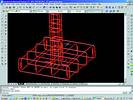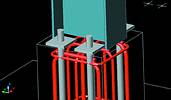Convergence of technologies contributes to better safety standards
December 2002
Convergence of design technology and structural analysis software will contribute to improved built environment safety standards. That is the opinion of Louis Viljoen, a member of the team of Prokon Software Consultants' structural engineers that incorporated the company's Prokon structural analysis software with internationally developed Autodesk design technology, to create an integrated structural design application.
Prokon comprises a comprehensive suite of modules for frame and finite element analysis, steel member and connection design as well as concrete design and detailing. The software is used in more than 80 countries and has become the de facto standard in many countries that use British design codes. "In our opinion, convergence of technologies was a necessity, not simply a nice-to-have upgrade," explains Viljoen.
"All built environment project team members work under extreme pressure, particularly when projects are fast-tracked. For a structural engineer, having to go back and forth between design and structural analysis programs is frustrating and time consuming, and could result in someone taking a short cut."
In addition to integrating its structural analysis software with AutoCAD, Prokon has extended its product offering by creating a new product - ProDesk. The new software combines the company's structural analysis software with Autodesk's model-based design technology, Autodesk Architectural Desktop.
Viljoen, who is also ProDesk product manager, believes the combined technologies offer considerable productivity gains and also promise to alter the way in which built environment professionals collaborate on projects. "Because the nature of model-based design lends itself to the re-use of design data, I think we will see professionals collaborating much more closely in future," says Viljoen.
"For example, an architect will create a single model, embedded with every shred of design data, from dimensions, window specifications and a bill of materials to external reference documents and object-specific notes. That same data will be used in the development of the design and the generation of detailed drawings.
"I predict that it will not be long before allied consultants share the knowledge contained in the original model, each adding their own layer of data - be it civil or structural engineering calculations, airconditioning specifications, or electrical schematics."

These reinforcement cages for a concrete column and its footing show off the 3D reinforcement detailing capabilities of ProDesk
One of the biggest benefits offered by Autodesk model-based design technology is the ease with which revisions can be made. Because all the design data is contained in the original model, revisions are made once to the model. All views are automatically updated. "Time savings achieved in downstream revisions will give structural engineers time to focus on engineering and design, and not on churning out detailed drawings." Users of ProDesk can work in 2D or 3D, however, Viljoen points out, that 3D is no longer about providing attractive presentations. It can, in fact, help engineers proactively pin-point possible problem areas.

Visual inspection in 3D reveals a clash of reinforcement and holding down bolts in a stub column
An example would be the task of fitting holding down bolts between stub column reinforcement in the pad footing of a steel column. The position of the bolts relative to the steel column is critical to achieve a design strength for the steel column-to-footing connection, so too the position of the reinforcing within the concrete stub column. The challenge is to balance these two requirements and still produce a practicable foundation solution. With 3D reinforcement detailing, determining the viability of a solution is only a matter of taking a look at the 3D output. Changes can be made to the model and the influence on design strength checked immediately, using ProDesk in conjunction with Prokon's structural design suite.
For more information contact Autodesk, 012 664 8115.
Others who read this also read these articles
The high-end MCAD and cPDm market segments of the PLM strategy
CIMdata considers the high-end MCAD market to include only those few CAD solution providers that deliver very comprehensive computer-aided design and analysis capabilities that are also tightly integrated with an enterprise-capable cPDm solution from the same supplier[ December 2005 ]
SA's prototype designers awarded
The SABS Design Institute is the driving force behind design promotion in the country through various award schemes, supporting innovation and entrepreneurship[ October 2005 ]
2D to 3D: the path to better products, faster and cheaper
Modern 3D CAD systems allow designers and engineers to edit a few parameters and automatically create the downstream deliverables for unique variants in minutes, instead of days or weeks[ October 2005 ]
ECL in Africa
ECL ensures a worldwide coverage of its client base through local service units which incorporate all the ECL know-how[ August 2005 ]
Catia brings business to South Africa
The fact that the A400M contracts were awarded to local enterprises is a strategic breakthrough for the South African aerospace industry[ August 2005 ]
Strand7 analyses the Beijing Water Cube
The latest Strand7 Release 2.3 has added the capability to take site specific seismic time histories and simply create equivalent spectral curves[ June 2005 ]
Pro/E versus SolidWorks
In summary, SolidWorks' swept surfaces and solids are more limited in their capabilities than Pro/Engineer's[ June 2005 ]
Northern Railway Extension receives green light
Windhoek Consulting Engineers was appointed as consulting engineers for the Northern Railway Extension, responsible for all aspects regarding the design and construction supervision of the total project valued at N$ 1,4 billion[ April 2005 ]
Others who read this also read these news items
Digitising a standard racing engine provides a springboard for future improvements
[ December 2005 ]
Nelson Mandela Metropolitan University leads the way with Catia V5
[ December 2005 ]
Integrated CNC solution for SA tooling industry
[ December 2005 ]
Accelerated design at Donkin Fans
[ December 2005 ]
PGF transforms its vision into reality
[ December 2005 ]
Defy introduces new product range
[ October 2005 ]
New Smarts for legal eagles
[ October 2005, Cadshop ]
Vectorworks scores with architects on ease of use
[ October 2005 ]
Others who read this also read these regulars
Search Site
Subscribe
Previous Issues
Other Technews Publications
Other Technews Buyers Guides
 |  | Copyright c1995-2009 Technews Publishing (Pty) Ltd.. All rights reserved. |